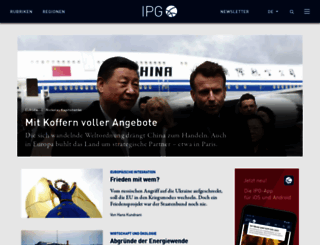Journal für Internationale Politik und Gesellschaft | IPG Journal
Page Load Speed
2.8 sec in total
First Response
286 ms
Resources Loaded
2.2 sec
Page Rendered
282 ms

About Website
Welcome to ipg-journal.de homepage info - get ready to check IPG Journal best content for Germany right away, or after learning these important things about ipg-journal.de
Internationale Politik und Gesellschaft (IPG). Die Zeitschrift für internationale Beziehungen und globale Trends
Visit ipg-journal.deKey Findings
We analyzed Ipg-journal.de page load time and found that the first response time was 286 ms and then it took 2.5 sec to load all DOM resources and completely render a web page. This is quite a good result, as only 45% of websites can load faster.